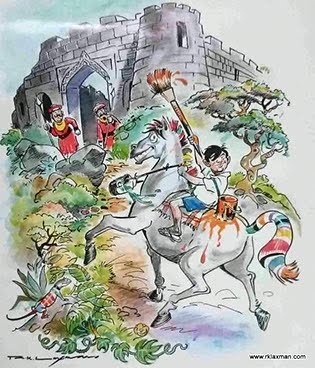Mascot Monday: How Gattu left a mark on Asian Paints
The moppet with a brush fomented the transformation of the paint industry in India
The moppet with a brush fomented the transformation of the paint industry in India
.jpg)
Back in the 80s, when people from rural North India wanted to paint their walls, they would specifically ask the shopkeeper for "bacha chaap paint." The picture of a little boy with a paintbrush was so impactful, that people didn't find it necessary to memorise the name of the brand -- in this case, Asian Paints.
Using moppets as mascots is an easy way to endear a brand to its consumers. Who could forget the Amul girl, the Parle G baby, the Murphy baby, and the chubby "Big Boy" mascot? One such moppet is Gattu who not only helped boost Asian Paints' business but also transformed the paint industry.
Up in smoke
Gattu was created at a time when cartoon mascots were very popular in advertising. A large part of the mascot's legacy is enriched by its own creator, the celebrated cartoonist R.K. Laxman, who was working for Asian Paints in the 1940s.
Up until then, painters were the sole customers of paint companies, but Asian Paints wanted to go beyond and reach out directly to the homeowners. The company was looking for means to appear more personalised and customer-friendly to its rural audience (who were its primary targets).
It was also a time when cartoon mascots like the Air India Maharaja were gaining a lot of popularity. Laxman was also tasked with finding the perfect cartoon persona for the brand.
As the legend goes, the artist envisioned a little boy in a plume of smoke he exhaled in one of his smoking sessions. He brought the vision to life by sketching the image of an impish little boy with a mischievous smile and unruly hair. In his hand, he held a paintbrush dipped in a bucket of paint.
But there was still the task of naming him.
Asian Paints organised a nationwide contest to christen the moppet for the prize money of Rs 500. From around 47,000 entries, two made the cut and both suggested the same name -- Gattu. Mr Rele and Mr Aras -- both from Bombay -- ultimately split the prize money equally.



Brat with a brush
The impish little boy was finally adopted as Asian Paints' mascot in 1954. Till the 70s, the brat could be seen in print ads, in the midst of various shenanigans like smearing paint on a bald man's head or ruining a painting with a stroke of the paintbrush. Each ad was followed by a tagline: "Any surface that needs painting needs Asian Paints."
With the birth of Gattu, Asian Paints' sales soared ten times in the four years that followed. The company also succeeded in drawing the attention of homeowners who hitherto didn't take much interest in wall paints.
The country grew so fond of the bratty little mascot that he became entwined with the brand itself with customers insisting on "bacha chaap paint."
Gattu also headlined many well-known campaigns of Asian Paints such as "Har ghar kuch kehta hain" in the 90s.



All was well until Asian Paints had a change of plan. Gattu fit in perfectly with the brand image when the company was producing cheaper paints for rural and semi-urban markets in the 40s.
However, with the turn of the century, Asian Paints wanted to go from being a simple wall paint company to a more diversified brand, supplying colour for various surfaces in various finishes.
Was Gattu the way forward for the brand even as it ventured into a more premium and sophisticated territory? Not quite.
The moppet became an albatross on the brand's neck, a vestige of its more humble past. As valuable as he was to the company, Gattu didn't match the image that Asian Paints wanted to project going into the new century.
Research showed that Gattu was being recalled less by consumers compared to Asian Paints' Apex and Ultima. The writing on the wall was clear -- Gattu had to go.
But instead of doing away with him suddenly, the brand decided to phase him out by downplaying him in ads little by little. By 2002, Gattu was retired once and for all.
Despite not being seen in any recent ads, Gattu's legacy lives on. Even to this day, people associated the shaggy-haired boy with the brand. The nation's obsession with the little boy and his mischievous ways transformed paint into a product that was no longer the domain of just the painters but also the homeowners.
References:
Advertising Principles and Practice. (2012). India: S CHAND & Company Limited.
Singh, R. (2021). A History of Indian Advertising in Ten-and-a-half Chapters. India: Hachette India.
Sople, V. V., Trott, S. (2016). Brand Equity: An Indian Perspective. India: Prentice Hall India Pvt., Limited.
Ramamurthy, R. (2021). Branded in History. India: Hachette India.